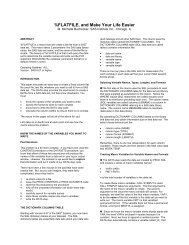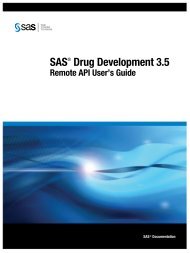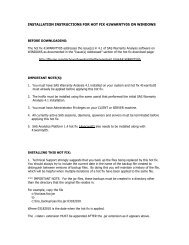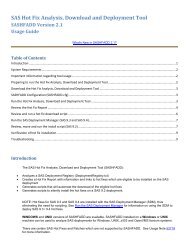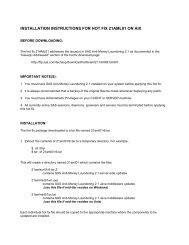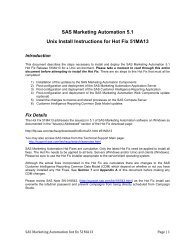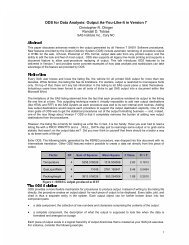SAS 9.3 Web Applications: Clustering - Index of - SAS
SAS 9.3 Web Applications: Clustering - Index of - SAS
SAS 9.3 Web Applications: Clustering - Index of - SAS
Create successful ePaper yourself
Turn your PDF publications into a flip-book with our unique Google optimized e-Paper software.
Overview<br />
1<br />
<strong>Web</strong> Application Server <strong>Clustering</strong> Overview . . . . . . . . . . . . . . . . . . . . . . . . . . . . . . . . . 1<br />
<strong>SAS</strong> Middle-Tier Limitations . . . . . . . . . . . . . . . . . . . . . . . . . . . . . . . . . . . . . . . . . . . . . . . . . . 2<br />
<strong>SAS</strong> Workflow . . . . . . . . . . . . . . . . . . . . . . . . . . . . . . . . . . . . . . . . . . . . . . . . . . . . . . . . . . . . . 2<br />
Java Messaging Services . . . . . . . . . . . . . . . . . . . . . . . . . . . . . . . . . . . . . . . . . . . . . . . . . . 2<br />
Strategies for Overcoming Limitations . . . . . . . . . . . . . . . . . . . . . . . . . . . . . . . . . . . . . . . 3<br />
<strong>Web</strong> Application Server <strong>Clustering</strong><br />
Overview<br />
The <strong>SAS</strong> <strong>Web</strong> applications can be clustered to improve performance and to provide<br />
high availability. Performance is improved due to additional server instances to<br />
handle requests and distribution <strong>of</strong> memory needs to additional processes.<br />
Performance can also be improved by deploying servers on to additional hardware.<br />
<strong>Clustering</strong> can also provide high availability. If server instances are clustered on a<br />
single machine, then there is protection against s<strong>of</strong>tware failure. If multiple machines<br />
are used for clustering servers, then the additional machines in the cluster provide<br />
protection from s<strong>of</strong>tware failure and protection from hardware failure. This document<br />
provides application-specific considerations for clustering and <strong>Web</strong> application<br />
server-specific details for clustering the <strong>SAS</strong> <strong>Web</strong> applications that are deployed with<br />
<strong>SAS</strong> Enterprise Business Intelligence Server.<br />
Here are the high-level steps to follow:<br />
1 Plan for Deployment: Using functional and non-functional requirements as well<br />
as a sizing and capacity plan, determine how many servers you need and the<br />
server capacity that you need.<br />
2 Choose Deployment Plan: Based on the input from the previous step, choose a<br />
deployment plan that uses single or multiple servers.<br />
3 Install <strong>SAS</strong> S<strong>of</strong>tware with the <strong>SAS</strong> Deployment Wizard: Use the wizard to install<br />
<strong>SAS</strong> s<strong>of</strong>tware either interactively or non-interactively. The interactive method<br />
provides a series <strong>of</strong> prompts to enable you to modify parameters based on your<br />
environment. Alternatively, you can configure a response file with parameters for<br />
your environment and run the wizard in noninteractive mode. On the first<br />
machine in the middle tier, use the <strong>SAS</strong> Deployment Wizard to install and<br />
configure s<strong>of</strong>tware. You can choose to have the wizard automatically configure<br />
the <strong>Web</strong> application server, or configure the <strong>Web</strong> application server yourself. If<br />
you choose to configure the <strong>Web</strong> application server yourself, follow the steps in<br />
the Instructions.html file that is generated by the wizard. On the additional<br />
1





